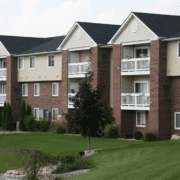The Outliers of the Real Estate Waterfall World
Guest Author: Adam Gower PH.D., GowerCrowd
When investing in a real estate project as a passive partner, cash distributions are calculated and made using what is called a ‘waterfall,’ most of which are structured according to reasonably uniform standards, and some of which are more creative.
According to RealPage IMS, the industry-leading investment management technology company for commercial real estate, commonly seen waterfalls offer an 8 percent preferred return with a 90-10 or 80-20 split of the profits to the investors and developers respectively.
There may then be a break where the split changes to 70-30 or 60-40 once investors have received a certain internal rate of return (IRR), perhaps a 12 percent or 15 percent IRR.
The important point here is that the most commonly used metric used to define the breakpoint in waterfalls is the IRR.
Wacky Waterfalls
Where waterfalls start to get wacky is where the sponsor calculates the breakpoint based on a ‘greater of something’ calculation. They may make the split dependent on reaching the greater of either a 15 percent IRR or a 1.5x equity multiple.
This creates the requirement of figuring out which of those two is the greater at any point in time before moving down to the next layer of the waterfall.
To further complicate these waterfalls, some organizational structures have multiple classes where the overall return metrics – whether it be a preferred return, an equity multiple or the IRR, or some greater-of combination – differs between the various classes for different investors.
Side Letters
Another outlier in waterfall structures are those where there are side letters between a sponsor and their investors within different classes. These side letters are unique to not only the class, but also to the investors in this class, or maybe only a certain number of investors in that class.
Side letters, when they occur, typically articulate a deviation of some sort from the standard operating agreement by offering different treatment to specific investors in terms of the returns they are getting. That’s not to say that these are necessarily better terms to the investor that has that side letter than the rest of the investors in that class. They are just different, and they create another layer that complicates the overall math, from the project level down to each one of those individual investors.
When they are used, side letters are most commonly designed as a method of rewarding loyal investors, those who have been with a sponsor for a long time and invest in most if not all deals the sponsor offers.
In these cases, the loyal investor might be provided with a level of return consistent with the returns they have become accustomed to during the course of their relationship with the sponsor. For example, when an investor who’s been investing over a period of time, including at the early part of a cycle when returns are typically higher, as the cycle approaches its end and returns compress, sponsors can use side letters to prop-up returns for loyal investors to ensure that they maintain an early-cycle return profile.
The way this is typically effectuated is either through a higher preferred return, or through having a larger piece of a split, as the investor moves through the different hurdles. For example, these loyal investors may get a 20-80 split whereas all the other investors get a 10-90.
The No-Preferred Return Waterfall
Of course, sponsors don’t necessarily have to offer a preferred return, and while very rare, projects that don’t have preferred returns do exist. Two examples of actual deals are as follows.
One project had no preferred return and a straight 70-30 split from dollar one, i.e. for all distributions from available cash flow as well as from distributions from a liquidity event including refinance or sale.
Another actual case involved a $100MM multi-family-office residential development project with a $35MM equity piece. All distributions from cash flow were split 75-25 investor-sponsor, with investor capital paid first from refinance or sale proceeds, and all subsequent revenues from cash flow reverting to the 75:25 split. In this case, as the deal was a development project, investors did not receive any distributions until the project started generating revenues from operations after 3 years.
Consequently, during the development period, investors received no cash flow and no accrued return of any kind. Furthermore, in the event of a refinance, only that portion of invested capital that could be paid off by the refinance, projected at inception to be 70%, would be paid down before the 75-25 split kicked back in.
Despite these actual examples, not having a preferred return is the rarest of waterfall structures according to RealPage IMS whose investor management software currently has in excess of $40bn of equity positions represented on the platform.
Waterfall Outliers
The next outlier, being slightly less uncommon, is where there is a preferred return but that it only starts to accrue when there’s cash flow generated at the property. As infrequent as these are, when they do show up, they occur in development or value-add deals. In these unusual waterfalls, an investor puts their money in knowing that the clock on accruing preferred return doesn’t start until there’s actually cash flow at the property.
The next outlier, being less uncommon still, is that preferred return does accrue at the inception of the deal but isn’t paid for a period of time; it just continues to build during the non-cash flowing period of the project. In those cases, the GP will often have a catch-up before capital is paid back to investors. The catch-up will most often be calculated as follows. If the excess capital split after the preferred return has been paid is, for example, 70-30, the sponsor will receive that same split as a percentage of however much investors were paid in preferred return.
Putting that into actual numbers. If the deal structure is an 8% preferred return followed by a 70-30 split and an investor’s investment is $1MM, the returns after two years, presuming there were enough cash available for distribution, would look like this:
- – Investors would receive 8% accrued for 2 years on their $1MM investment = $160,000
- – Next the sponsor would receive their 30% promote on that paid out accrued preferred return so 30% of $160,000 = $48,000
- – Next would be either continued distributions of cash to pref and catch-up
- – Then comes return of $1MM original invested capital.
- – Finally, 70-30 for all remaining distributions.
Notably in some of these cases, the preferred return might be higher than would commonly be seen if the pref was paid current from moment of investment, be that monthly or quarterly. Having said that, these situations are not common and there is no positive correlation between having an unpaid accrued return and having a higher preferred return.
Articulating the benefits of your waterfall to nurture relationships with existing investors and to attract new ones is an important part of standing out in the crowd, and effectively delivering that message digitally is a minimum standard today.
***
This post was created in cooperation with the GowerCrowd. Adam Gower is a 30+ year veteran real estate investment and finance professional. He expands investor networks for real estate developers by implementing best-of-class digital marketing programs.











